Century Camera Co.
Rochester, NY
The Century View Variation
2.0
Century
Catalog 1903, p. 51
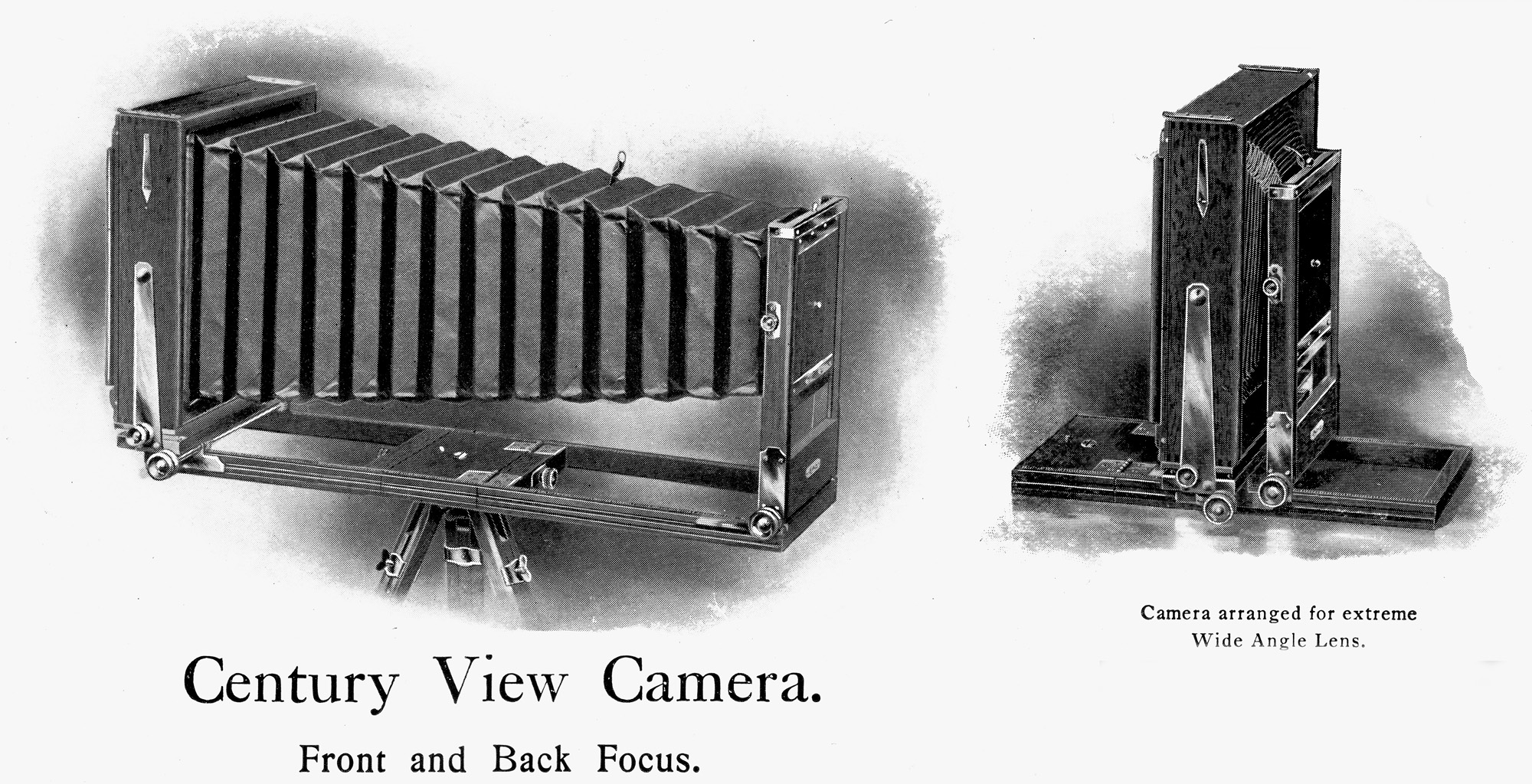
5 x 7"
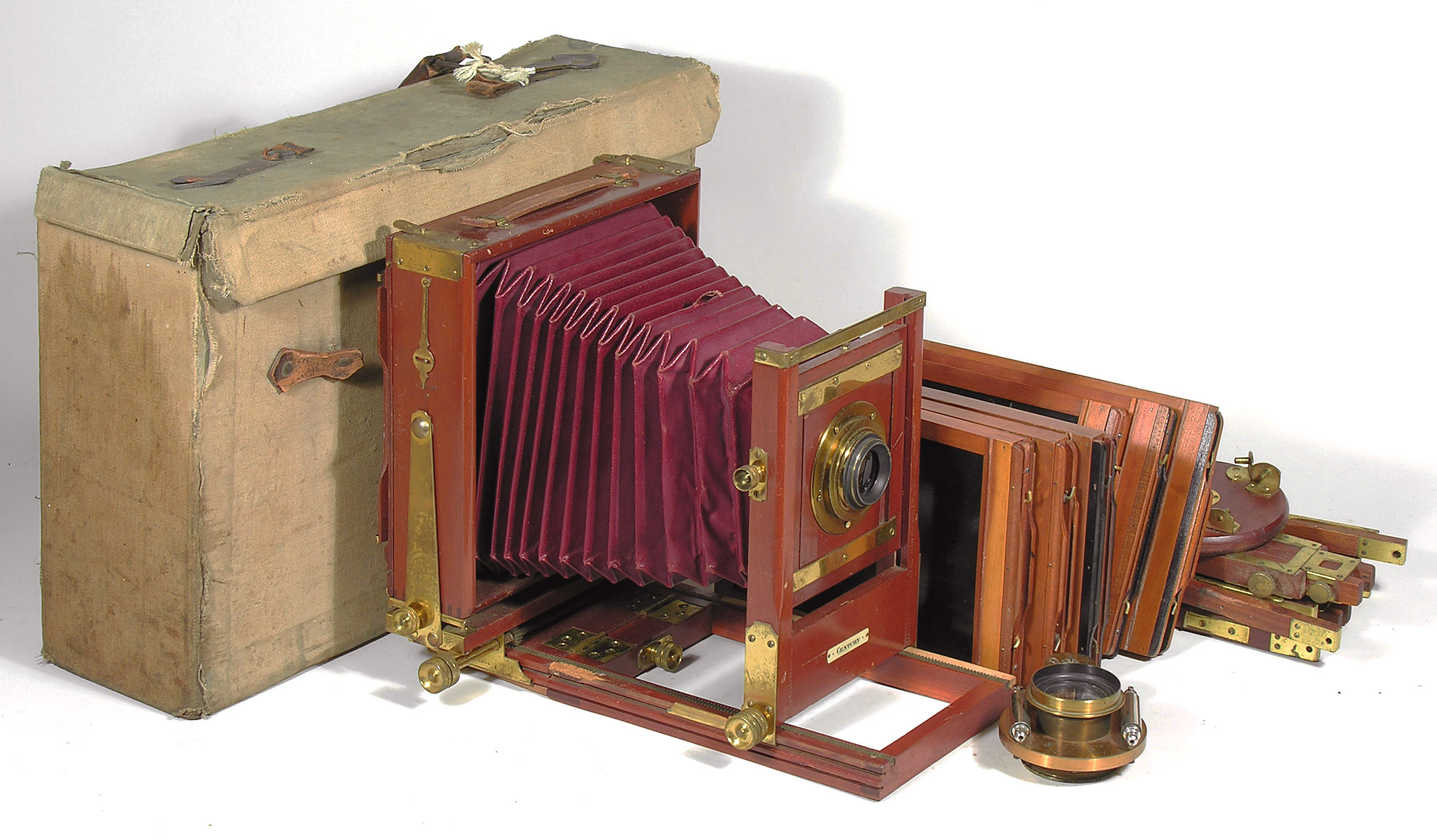
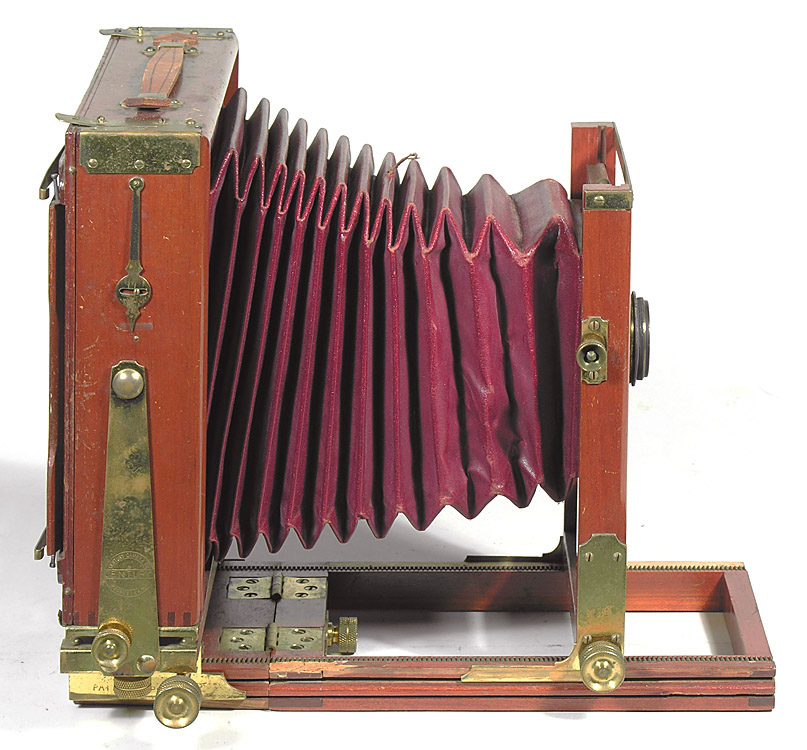
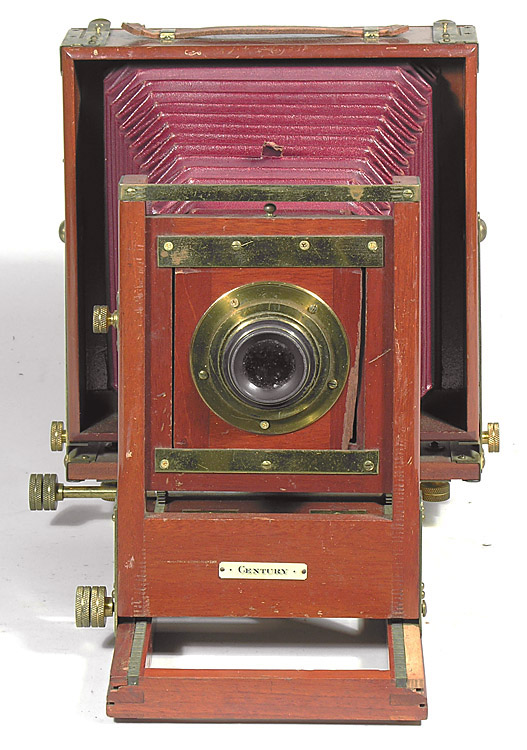
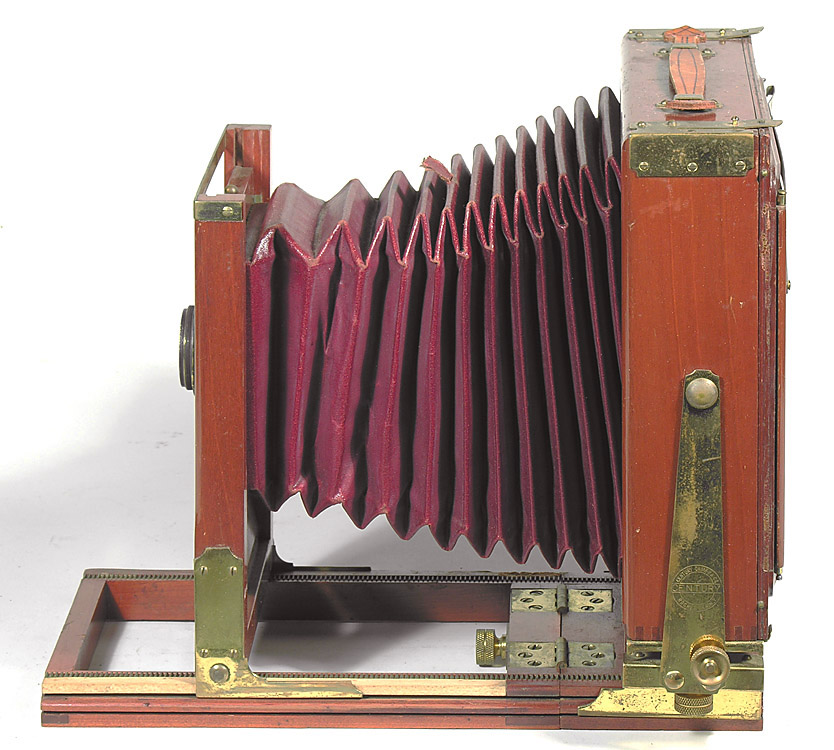
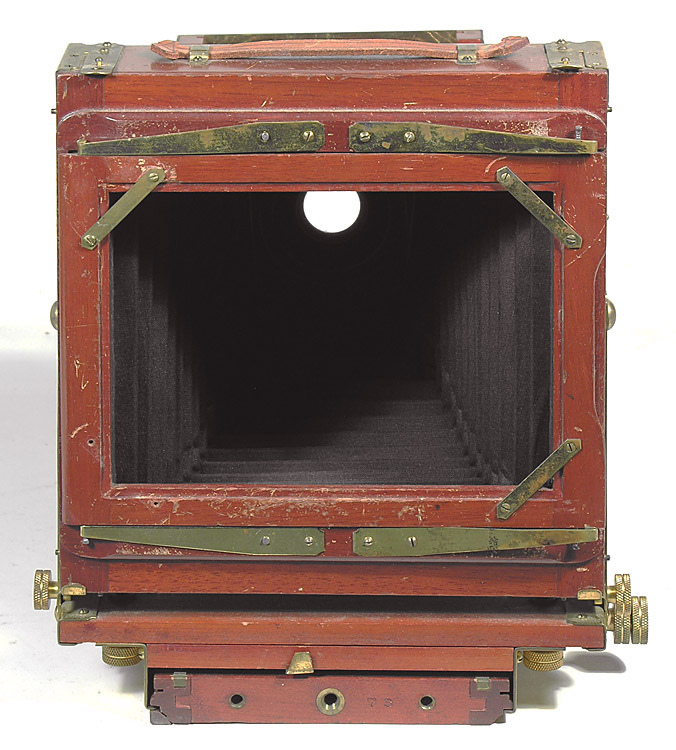
8 x 10"
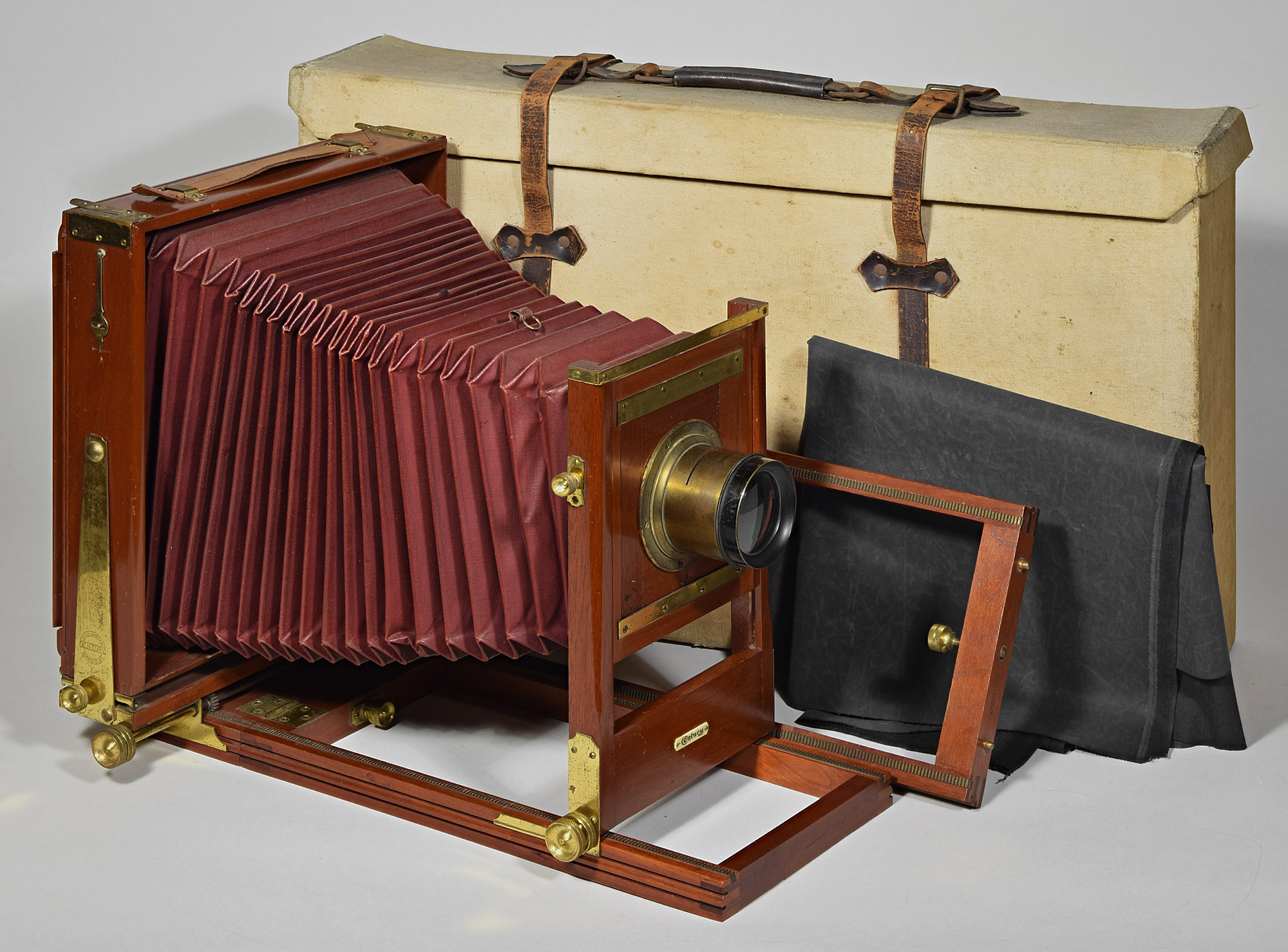
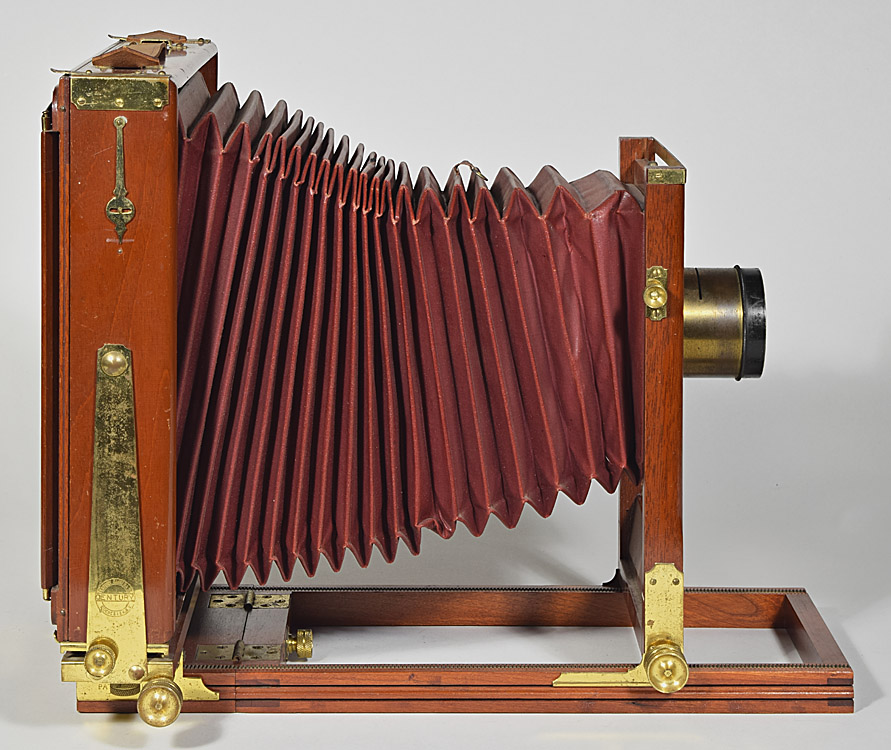
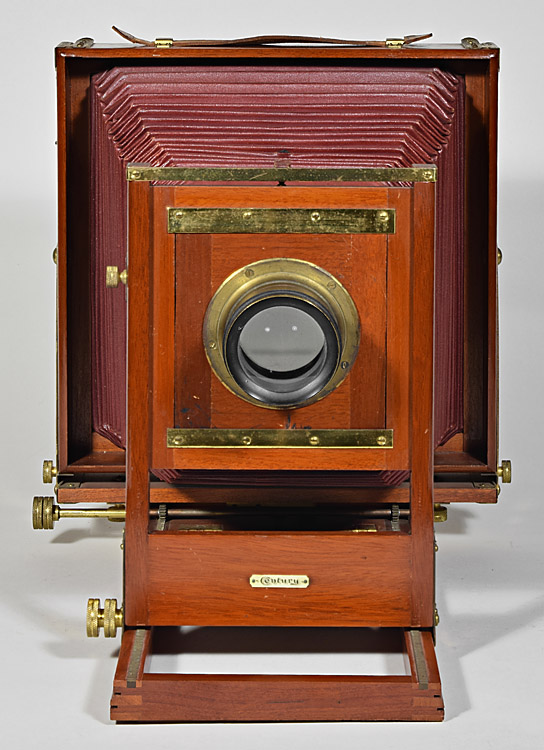
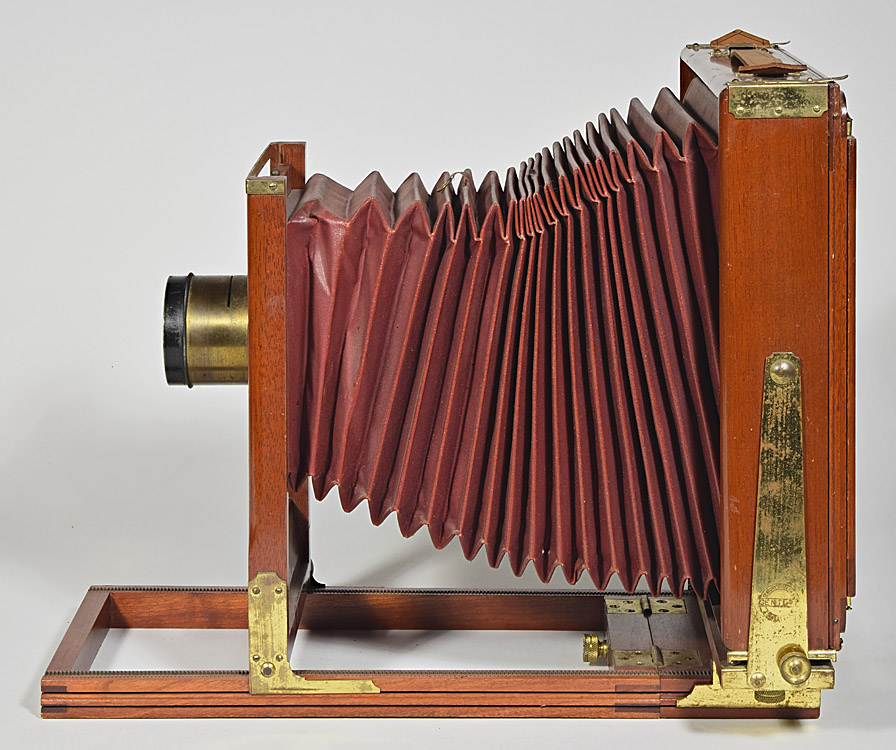
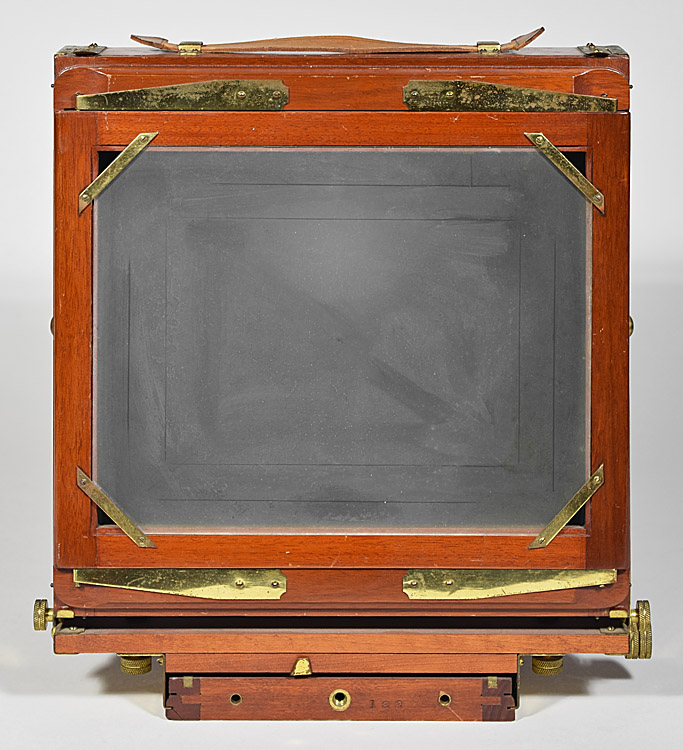
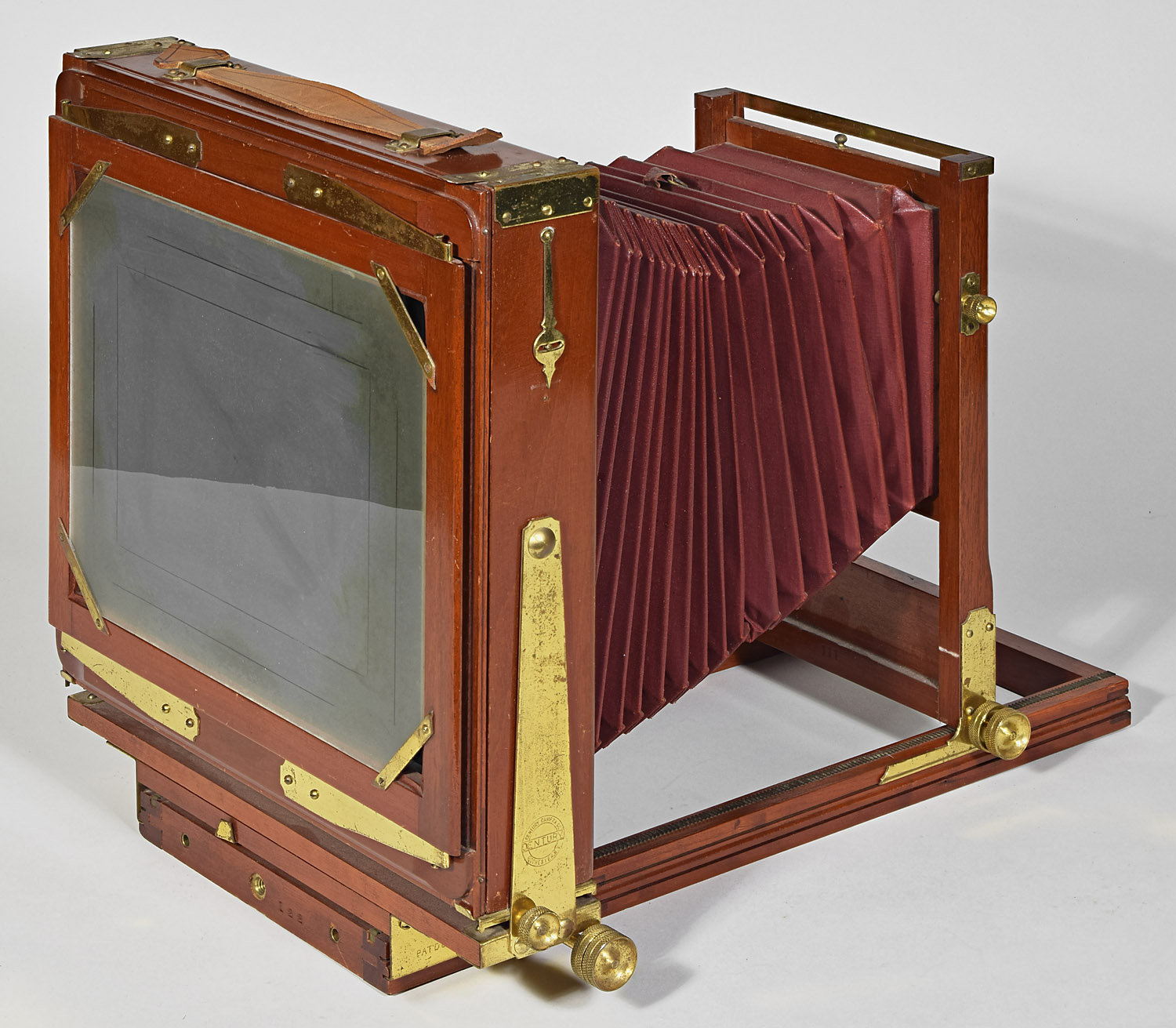
Bottom
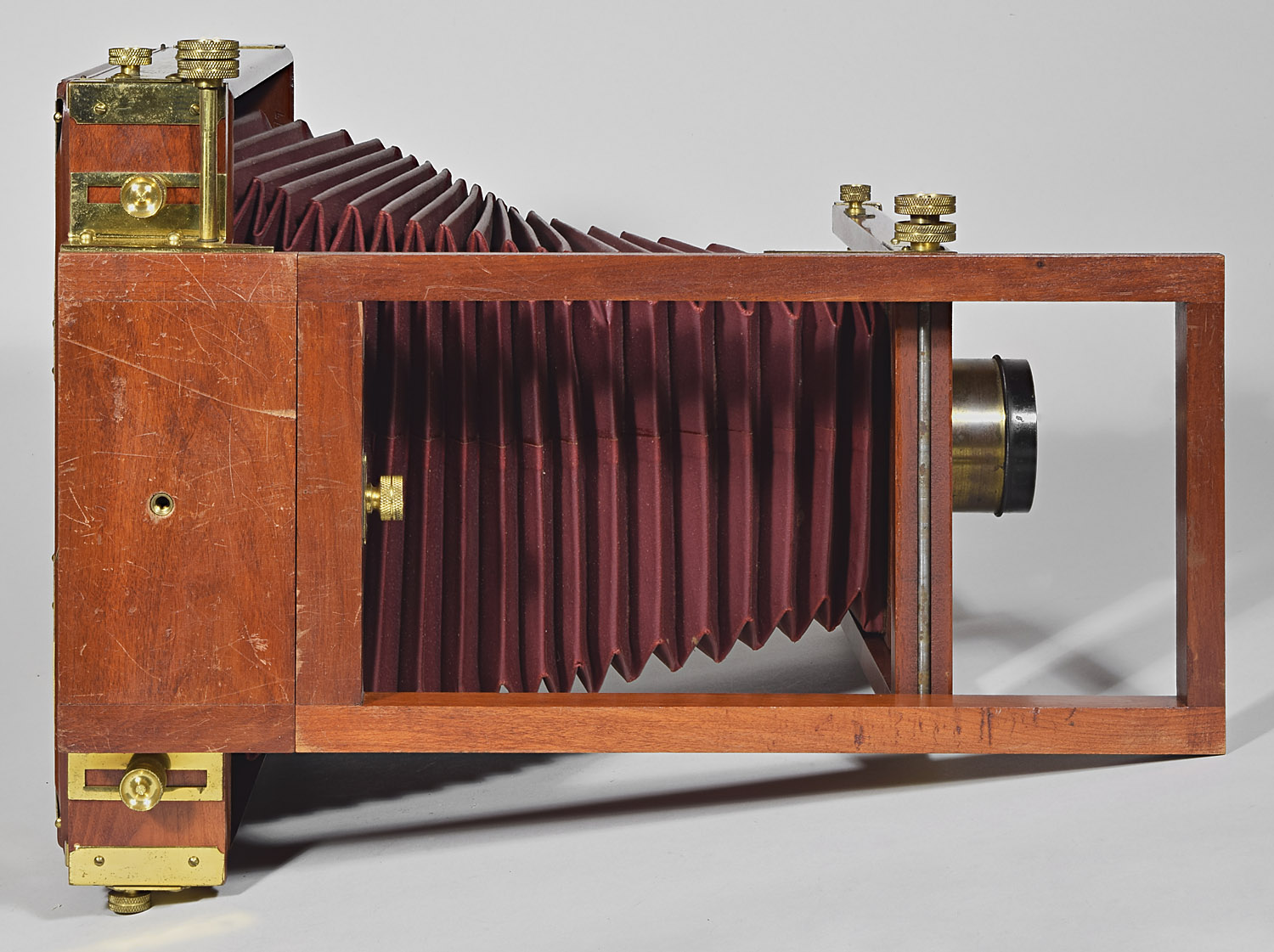
Top
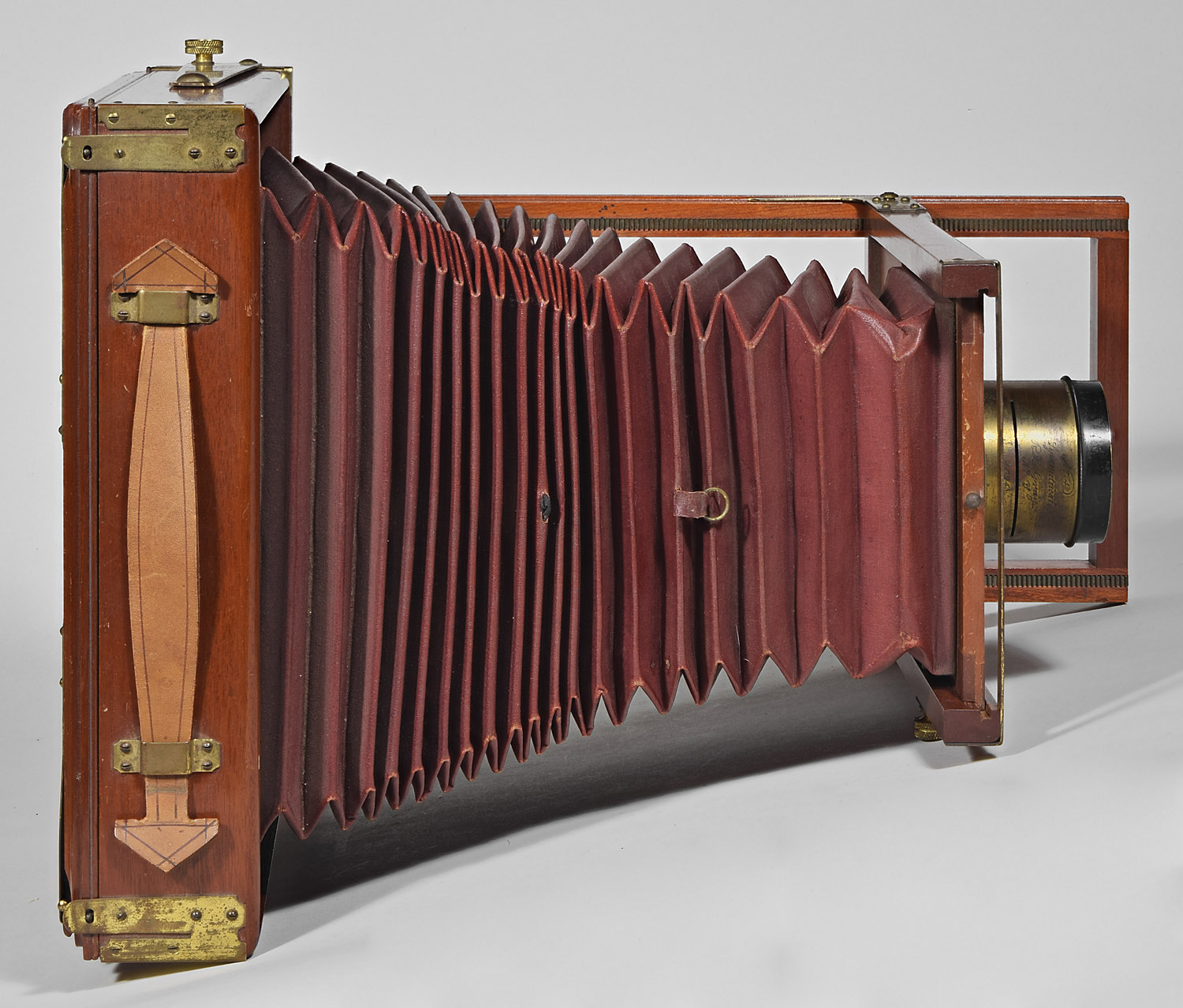
Label, cellulied, lower front standard

Stamp, serial number 122, rear edge of main platform
(and matching number on the edge of the rear extension).
Notable is the nice inlet screw thread (center hole) for assembling the
full platform. Much rarer in view camera manufacture is that the
flanking two holes (for the guide pegs on the extension) are not bare,
but clad with metal.
Finally, note the spring loaded metal tab, which prevents the camera
from being cranked or focused off the end of the track when the
extension is absent. The tab is moved to the left to enable
cranking past it. It is not quite as slick as the automatic stop
on the
Rochester Optical Co.
Empire State Improved, but
still handy.

Date Introduced: - ; Years Manufactured:
c.1902 -
c.1903
Construction: front and rear focus
via rack and pinion (two gear tracks on top of base rails);
double swing; reversing by removable back; three-piece lens board
Materials: mahogany wood body; cherry base;
black fabric bellows; brass hardware
Sizes Offered: at least
5x7 (photos above) and 6½x8½
Notes:
Century Camera Co. View Cameras,
General:
The Century Camera Co. was founded
in 1900 - hence the name. After only 3-4 years of operation, George Eastman
(E.K.C.) acquired a controlling
interest in the company in 1904, after which it became the Century Camera Division,
EKC in 1907. Cameras named Century View Camera,
Century View Camera No. 1 and Century View Camera No. 2
were advertised. The Century View Camera would seem to be
the obvious precursor to the
Century
View Camera No. 1 and
Century
View Camera No. 2, yet it was
advertised concurrently with them.
To tell
apart cameras made in Rochester after 1900 (the Century Camera Co.'s
Century View
Camera,
Century View Camera No. 1 and
Century
View Camera No. 2, Rochester Optical Co.'s
Empire Stat View Camera
and
Improved Empire State View Camera, and the Eastman Kodak Co.'s
Eastman View Camera No. 1
and
Eastman View Camera No. 2), one must revel in minutiae. Since I apparently do revel
in minutiae, below are a number of variations of almost identical
cameras having almost identical names, so to quote a companion of BBC's
Dr. Who: "Here is where it gets complicated".
Century Camera Co. View Camera
Variations:
1900?-1901:
The first view cameras advertised by the fledgling Century Camera Co.
were two models manufactured by the Sunart Photo Co.: the
Vici View Camera
and the
Vidi View Camera.
A simple label reading: Century was installed to make it a
Century View Camera. Oddly, both Sunart models were sold
apparently under the one same model name:
Century View Camera.
Century View Camera Variation 1.0
This variation was a resale of the
Sunart Photo Co. Vici View Camera,
a front- and rear-focus model. This variation was advertised only
in
the 1901 Century Camera Co. catalog, p.24. But there would have been
no reason not to sell it starting in 1900 (since Sunart was selling it
as a Sunart camera), although there is so far no evidence that it was.
Century View Camera Variation 1.5
The variation was a resale of the
Sunart Photo Co. Vidi View Camera,
a rear-focus only model. This variation was not advertised,
although it most surely was sold, since at least two examples of it
exist having Century labels. It is presumed that this variation was sold during the same
period of time that
Century View Camera Variation 1.0
was advertised (that is, only about 1901).
1902-1903:
The first view cameras made by Century.Century View Camera Variation 2.0
This camera was the first Century model
actually made in the Century factory rather than being purchased from
the Sunart Photo Co. It is front and rear focus, like the
Sunart-manufactured
Century View Camera Variation 1.0,
but it is the first Century camera (or perhaps the first camera model of
any manufacturer) to feature the newly patented double-groove platform
(Locke - US704,845 - Jul.15.1902). It is also the first Century
camera to utilize the straight rear standard forward/backward swing
hardware that all Century cameras would keep from here on. Another
innovation that would be kept was a very useful spring-loaded small
device inlet into the rear of the platform that allows the rear standard
to be rolled onto the rear extension while the extension is present, yet
prevents it from rolling off the track when the extension is not
present. This
camera also had, for the first time to be used in all Century view
cameras to come, a system to retain the lensboard that consists of two
long brass retaining strips and a spring hidden behind the upper strip.
To install a lens board, the user merely has to put the upper edge of
the lens board behind the upper retaining strip, push up against the
spring until the bottom edge of the lens board clears the lower
retaining strip, and let the lens board go down - now behind both
retaining strips. It is a great design, there being none of those
small brass pieces to be turned to retain the lens board, as there were
in almost if not all other view cameras before this time. Century
did, however keep the front standard design of the Sunarts it had been
buying - i.e., a small thumbscrew high on the right side for front rise/fall.
Century View Camera Variation 2.1
This model has front and rear focus and the same
rear standard design as the
Century View Camera Variation 2.0, but
the
Century View Camera Variation 2.1
dropped the
small rise/fall thumbscrew high on the front standard in favor of a design that
features a slot and thumbscrew, which is mounted just above the rather
tall front standard supports. The slot has a brass surround that is a tough
bearing surface to which the thumbscrew locks. This is a marked
improvement over the Variation 2.0 and earlier, in which the thumbscrew
could screw into the wood of the front standard if tightened too much.
The change of the front standard was clearly a hit, as it was retained
in all subsequent Century view camera models. Indeed, the the
Century View Camera
Variation 2.1
is identical to the
Century View Camera No. 1
Variation 1.0, introduced in
1904, except for its horizontal label marked simply
Century.
The small, rectangular Century label was used apparently for all cameras advertised as the
Century View Camera,
regardless of variation. The large round label used for
the numbered view cameras: the
Century View Camera No. 1
and
Century View Camera No.
2.
Century View Camera Variation 2.2
This variation has front and rear focus and the same
rear standard design as the
Century View Camera Variation 2.1, but
the
Century View Camera Variation 2.2
has two unique clips on the inside ends of the hinged front standard
that holds the front standard in place once it has been folded up.
1904 & ff.:
Century view cameras being either a No. 1 or
No. 2,
included small refinements of the design, possibly a result of Century's
acquisition by the Eastman Kodak Co. and the resulting new ideas
therefrom. The
Century View Camera No. 1
and
Century View Camera No. 2
cameras were in catalogs concurrently from 1904 to c.1915, at which time
they were superseeded by the
Eastman View Camera No. 1
and the
Eastman View Camera No. 2,
which have dogleg-shaped rear standard forward/backward swing hardware.
The dogleg shape was adopted from the
Empire State Improved View Camera,
formerly made by from Rochester Optical Co., another Eastman
acquisition.
Century View Camera No. 1 Variation 1.0
To distinguish this camera from
The Century View,
Century added a
No. 1
to the name. This model has the same front and back focus as all the Century view
cameras except
Century View Camera Variation 1.5. It has the same rear standard as
Century View Camera Variation 2.0. In fact the catalog engraving
of the rear standard and bellows of
Century View Camera Variation 2.0
was re-used for the catalog engraving of
Century View Camera No. 1
Variation 1.0. This conclusion is based on looking closely at the
engraving details, inclusing the exact shape of the ribbon-like
attachment to the top of the bellows (there is another on the bottom of
the bellows, which can't be seen from the point of view) that allows the
extra-long bellows to be shortened to prevent sagging. The front
is identical to
Century View Camera Variation 2.1. Therefore,
overall,
Century View Camera No. 1 Variation 1.0 is identical to
Century
View Camera Variation 2.1, except that it has should have a round label
that reads: Century No. 1. Oddly enough, the engraving used for
the Century View Camera No. 1 does not have a round label, but shows the
earlier, horizontal label used for the earlier
Century View Camera
(advertised without being a
No. 1 or
No. 2). The confusion comes
from the Century saving the money of a new engraving by re-using most of
the engraving for the earlier model.
Century View Camera No. 1 Variation 1.1
This variation is identical to the
Century View Camera No. 1 Variation 1.0 except that the rear focusing
thumbscrew is on the left and at the rear of the rear standard, whereas,
in the
Century View Camera No. 1 Variation 1.0, it is on the right side and in front of the rear
standard. Since the left-handed configuration is never shown in an
engraving, it is hard to tell whether this variation is how it was made
for a period, or whether it is a custom left-handed camera.
Century View Camera No. 2
The
Century View Camera No. 2 is the
first Eastman Kodak view camera to have a triple grooved platform or
rail. The purpose of the third groove is to be able to slide into
it a piece of wood about 6" long. Ome problem with view cameras up
to this time is one of balancing a long, heavy camera on a tripod.
For a given photo, the center of gravity of the camera may be at a very
different point. The problem is worse for very long bellows
cameras, such as the Century views. Previously, manufacturers
either ignored the problem, or supplied a second tripod threaded
mounting hole (e.g.,
The Century View Camera Variation 1.5).
The solution here is that the extra piece has a tripod mounting hold,
and is infinitely adjustable as to where it is on the camera platform -
it can always be put at a point of balance for the camera, and therefore
present very little instability to the tripod. Otherwise, the
model appears to be identical to
Century View Camera No. 1.0.
References:
Century Cameras, Century Camera Co. (Rochester, NY) Catalog,
1902, pp. 45-46.
Century Cameras, Century Camera Co. (Rochester, NY) Catalog,
1903, pp. 51-52.
Back to Century Camera Co.

















